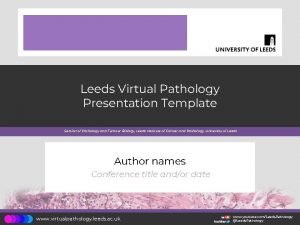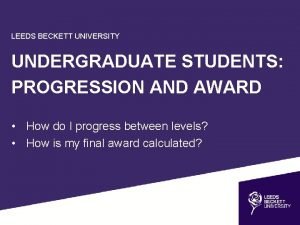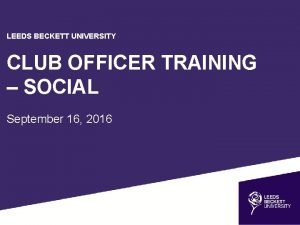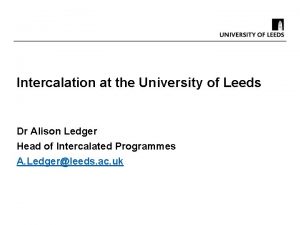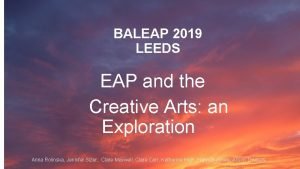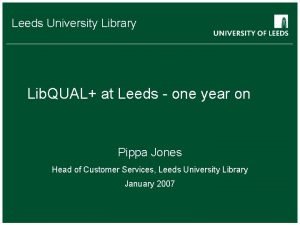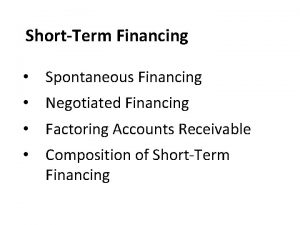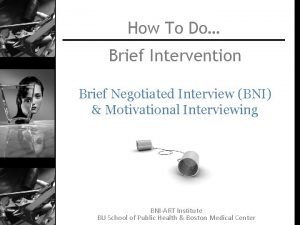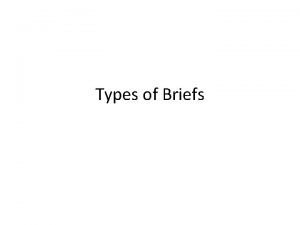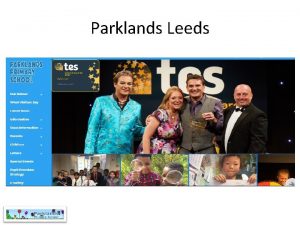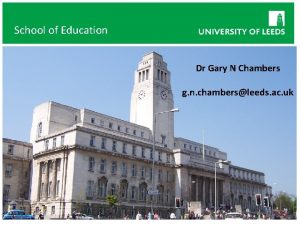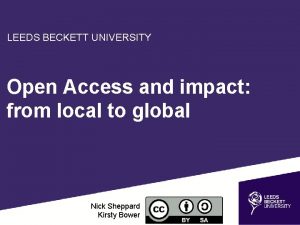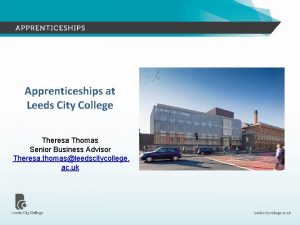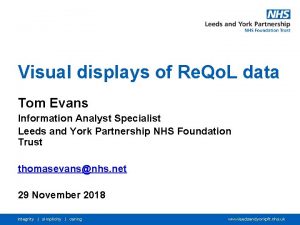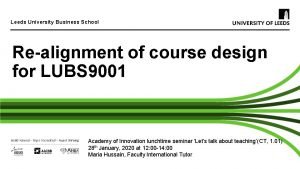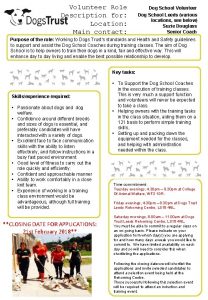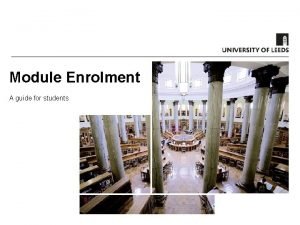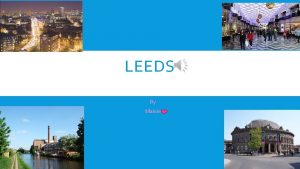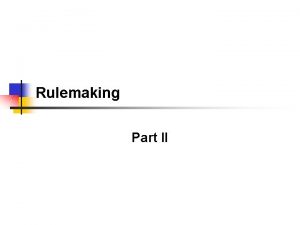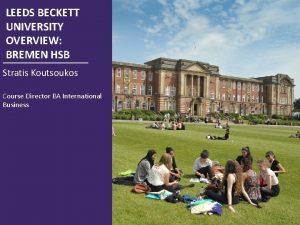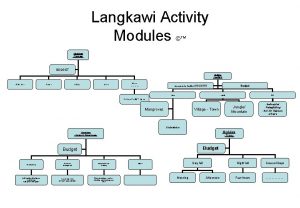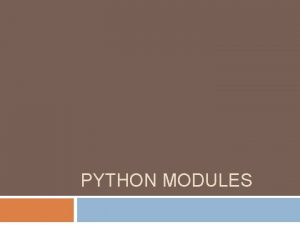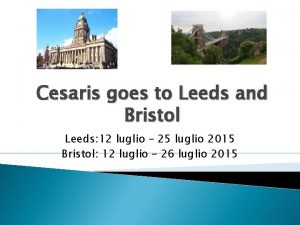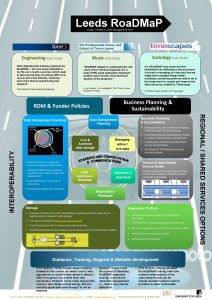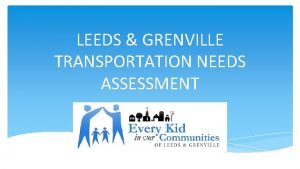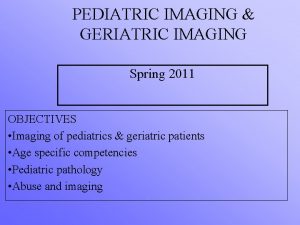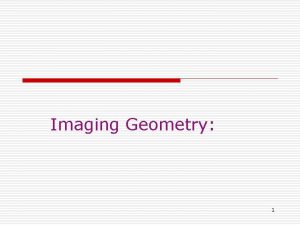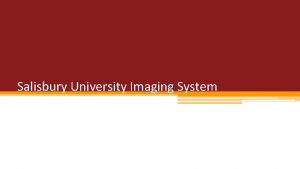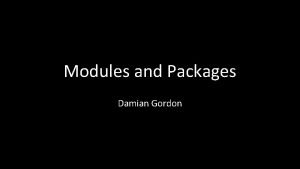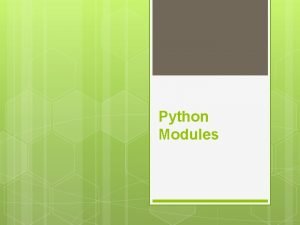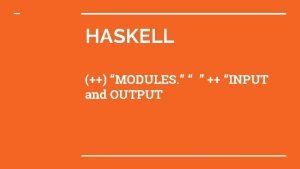Developing Negotiated Imaging Modules The University of Leeds
























- Slides: 24

Developing Negotiated Imaging Modules: The University of Leeds experience Jane Arezina

Aim of the session • To share our experience in developing negotiated imaging modules in specialist/focussed areas of diagnostic imaging.

Uo. L MSc Diagnostic Imaging Programme • Created by merging existing Breast Imaging and Medical Ultrasound programmes • Preserved the existing high-quality student experience • Increased opportunities for inter-professional learning • Streamlined delivery to ensure programme viability and sustainability

Rationale for Restructuring • Accommodate existing and emerging/niche specialists areas of practice • Course and module design to enable students to negotiate learning and assessment on an individual basis • Introduce flexibility and future-proofing

Negotiated Modules • Developed in response to increasing service and practitioner demand • Two negotiated imaging practice modules (15 credit and 30 credits options) • Accommodate the increasing number of areas of specialist professional development within Diagnostic Imaging • Enable students to undertake focussed or broader area study in a speciality depending on their individual clinical requirements

Specialities currently delivered in NIP and FNIP • Image Guided Interventional Procedures • Breast Ultrasound • Peripheral Vascular Ultrasound • Focussed aspect of a module e. g. First Trimester Obstetric Ultrasound • Not delivered 12 -13 but done in past – Musculoskeletal Ultrasound – Cardiac Ultrasound

Negotiated Imaging Practice (NIP) and Focussed Negotiated Imaging Practice (FNIP) • Multiple small groups studying a variety of clinical applications • Students negotiate their own learning, teaching and assessment with guidance from the module and strand leaders • Learning, teaching and assessment proposal moderated by Learning Contract Review Panel

The collaborative approach • Students develop and submit a learning contract outlining their proposed individualised programme • Panel of subject specialists (strand leaders) moderate to ensure parity, fairness and academic integrity of learning, teaching and assessment plan. • Locates academic control in successful student / tutor partnerships. • Clinical partners – Mentors monitor progress and undertake the summative clinical assessment in conjunction with academic from Uo. L

• Aim Summarise your overall aim(s) for this module • Justification Explain your reasons for undertaking this module • Knowledge base Provide a list of key literature and resources • Learning objectives Describe what you wish to achieve using 5 or 6 specific ‘knowledge & understanding’ and ‘skill’ outcomes » • Methods what do you want to know, understand / or be able to do, that you do not know / understand / cannot do, now? Outline a proposed programme of study » how will you be taught? what learning activities will you undertake? » describe in terms of hours / topics and numbers / case mix » how do you want your progress / practice / development of competence to be monitored? • Assessment Design your own assessment schedule » what evidence will you submit (and when) to demonstrate that you are making progress (formative assessment)? » what evidence will you submit (and when) to demonstrate that you have achieved your learning objectives (summative assessment)?

Assessment • Students in a sub-group may all be undertaking the same assessment if the learning outcomes are the same for all students; e. g. Breast ultrasound • Assessment within a sub-group may be different if students are studying the same ‘subject’ but in different clinical areas of practice e. g. Image-guided interventional procedures • Use of the School of Healthcare assessment tariff ensures that assessment is equivalent across the module

Application Written work Performance audit Clinical Learning record Hy. Co. Sy 1 x 1200 word case study; 3 x 400 case reports – to include one patient complication and one unexpected result. 30 successful unassisted procedures 30 unassisted procedures; documentation, report and follow up / reflection US Breast FNA & NCB 2 x 1200 word case studies 1 x FNA/ Cyst aspiration, 1 x 14 g NCB 30 FNA (70% adequate sampling); 30 x 14 g NCB (80% B 2 or B 5 result) - unassisted procedures At least 30 Breast FNA, 15 Cyst aspirations & 30 14 g NCB – unassisted procedures. images / pathology reports X-ray breast SNCB & HW 1 x 3000 word case study SNCB technique; 3 x 750 case reports – to include one patient complication, one discrepant result, one hook-wire procedure. 30 unassisted SNCB – 80% B 2 or B 5 result; 10 successful hookwire (10 mm threshold) At least 30 unassisted SNCB; 10 unassisted hookwires images / pathology reports US MSK Joint injections 1 x 1200 word case study 3 x 400 case reports to include one patient complication; one unexpected result 30 unassisted procedures Oxford shoulder score audit 30 unassisted procedures; documentation, images patient questionnaires

Written work 100% or 60% weighting OSE 40 % weighting Clinical Assessment Pass / Fail Clinical Learning record Pass / Fail At least 30 Breast FNA, 15 Cyst aspirations 30 14 g NCB - unassisted procedures IGIP (FNIP – 15) 2 x 1200 word case studies X 30 FNA 30 x 14 g NCB unassisted procedures Obstetric (FNIP – 15) 1500 word case report 30 minutes 2 clients 1 x less than 9 weeks gestation 1 x 10 -14+2 weeks Minimum 150 cases include 50 dating and 50 early pregnancy complications Vascular (FNIP – 15) 1500 work case report 30 minutes 2 patients 1 x arterial 1 x venous study Minimum 150 patients include arterial & venous studies Breast (NIP - 30) 3000 word case study 1500 word essay 30 minutes 3 patients 3 different referral reason to include 1 whole breast and axilla Minimum 100 cases

How it works • The negotiated aspects of the programme are not more than 50% of the award • Students without a previous PG imaging qualification need to do a programme of study. This has a minimum of two compulsory modules – Fundamentals of Science and Technology of Diagnostic Imaging – Professional Issues in Diagnostic Imaging • Students with a previous postgraduate (PG) imaging qualification can do these modules for Continuing Professional Development (CPD)

Creativity and Innovation in learning and teaching • Embeds the philosophy of student-led learning and teaching • Empowers students to take responsibility for their own learning • Enhanced integration of research and teaching • Motivates students to succeed

Student Focussed Learning • The flexibility of NIP/FNIP enables students to be self-directed learners • Negotiate learning to enhance individual clinical skills requirements • Experiential work-based learning enhanced by greater theoretical knowledge • Innovative assessment : negotiated to ensure assesses the individual learning outcomes including clinical competence

Problems (challenges) with NIP • Co-ordination of information to students • Timely administration of negotiated contract process • Co-ordination of assessment • Presentation of assessment results • Transcripts • Progression monitoring • Multiple ‘versions’ of the module • Duplication of learning

Outcomes This innovative approach has allowed us to: - • Achieve financial viability for specialist modules with low student numbers • Maintain an excellent student experience at Leeds • Be flexible and responsive to evolving clinical practice.



Feedback-March 2011 The MSc Diagnostic Imaging validation panel, including representatives from the Consortium for the Accreditation of Sonographic Education and the College of Radiographers, considered these modules to be excellent, innovative in postgraduate study and a model suitable for integrating research into learning and teaching. ‘‘…the Negotiated Learning modules, which were considered innovative and a model that could be extended to integrating research into learning and teaching’’ ‘‘This was considered by the panel to be an excellent idea for postgraduate study. ’’

Student feedback • ‘Experiential learning enabling linking theory to practice, multidisciplinary team work and communication enhancement’ • ‘Planning the workbased project very useful experience to structure ones own learning’ • ‘Having the scope to do relevant work and change practice’ • ‘Interactive teaching sessions enabled students to glean different practices in different departments and reflect on one’s own departmental processes’

Student feedback ‘Excellent module with good content and academic support. Would definitely recommend this to future students’ ‘Interactive discussions enabled different procedures, protocols and practices to be explored’ ‘I feel this has prepared me to perform a range of procedures with confidence and additional knowledge to reflect on in reference to professional guidelines and role extension’

Thank you

References BRAYE S. , M. LEBACQ, F. MANN AND E. MIDWINTER. 2003. Learning and social work law: an enquiry based approach to developing knowledge and skills. Soc Work Educ. 22 (5), pp. 479– 492 GIBBS V. 2011. The development of an innovative approach to postgraduate ultrasound education: An evolving process Radiography 17, 1, pp 28 - 32 HEALEY, M. 2005. Linking research and teaching to benefit student learning. Teaching in Higher Education. 29 (2), pp. 183 -201 MARQUARDT M. 2004. Harnessing the power of action learning. Train Dev. pp. 26– 32. PALMER S. 2002. Enquiry based learning can maximise a student’s potential. Psychol Learn Teach. 2 (2), pp. 82– 86. PEDLER, M. 1997. Action learning in practice (3 rd ed. ). Gower Publishing, UK PRICE B. 2001. Enquiry-based learning: an introductory guide. Nurs Stand. 15 (52), pp. 45– 52. REVANS R. 1980. Action learning: new techniques for action learning. Blond and Briggs, London. STARK S. 2006. Using action learning for professional development. Educ Action Re. s 14 (1), pp. 23– 43. WHITE, S. , A. IRONS. 2009. Relating Research and Teaching: Learning from Experiences and Beliefs. In: Ti. CSE ’ 09, 6 -9 th July 2009, Paris. [online]. [Accessed 10 th February 2011]. Available from World Wide Web: http: //eprints. ecs. soton. ac. uk/18205/
 Frc control system
Frc control system University of leeds presentation template
University of leeds presentation template Leeds beckett university awards
Leeds beckett university awards Colt materials leeds
Colt materials leeds University of leeds intercalation
University of leeds intercalation University of leeds padlet
University of leeds padlet Leeds business school library
Leeds business school library Example of spontaneous financing
Example of spontaneous financing Bni interview questions
Bni interview questions Types of client briefs
Types of client briefs Alison voice leeds
Alison voice leeds Dr fiona campbell
Dr fiona campbell Parklands leeds
Parklands leeds Lou harvey leeds
Lou harvey leeds Gary chambers leeds
Gary chambers leeds The leeds way values
The leeds way values Symplectic leeds beckett
Symplectic leeds beckett Maria hussain leeds
Maria hussain leeds Leeds city college apprenticeships
Leeds city college apprenticeships Raport de activitate consiliu parohial
Raport de activitate consiliu parohial Samantha pugh leeds
Samantha pugh leeds Asket croft leeds
Asket croft leeds Maria hussain leeds
Maria hussain leeds Animal volunteering leeds
Animal volunteering leeds Module enrolment leeds
Module enrolment leeds

